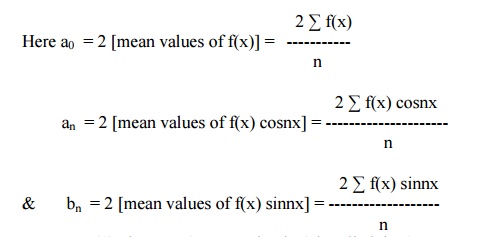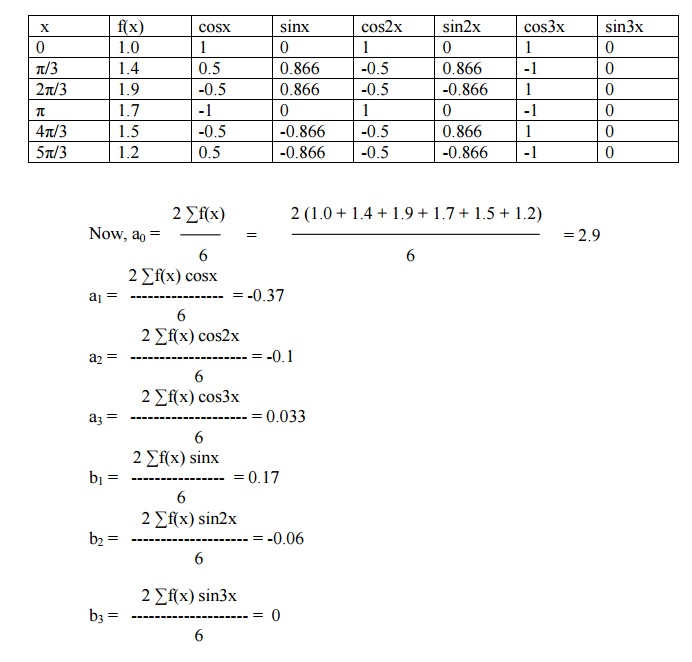Chapter: Mathematics (maths) : Fourier Series
Harmonic Analysis
Harmonic Analysis
The process of finding the Fourier series for a function given by numerical values is known as harmonic analysis.

ie, f(x) = (a0/2) + (a1 cosx + b1 sinx) + (a2 cos2x + b2 sin2x) + (a3cos3x + b3sin3x)+-------------ŌĆ”(1)

In (1), the term (a1cosx + b1 sinx) is called the fundamental or first harmonic, the term (a2cos2x + b2sin2x) is called the second harmonic and so on.
Example 16
Compute the first three harmonics of the Fourier series of f(x) given by the following table.

We exclude the last point x = 2ŽĆ.
Let f(x) = (a0/2) + (a1 cosx + b1 sinx) + (a2 cos2x + b2 sin2x) + ŌĆ”ŌĆ”ŌĆ”ŌĆ”
To evaluate the coefficients, we form the following table.

\ f(x) = 1.45 ŌĆō 0.37cosx + 0.17 sinx ŌĆō 0.1cos2x ŌĆō 0.06 sin2x + 0.033 cos3x+ŌĆ”
Example 17
Obtain the first three coefficients in the Fourier cosine series for y, where y is given in the following table:

\ Fourier cosine series in the interval (0, 2ŽĆ) is y = (a0 /2) + a1cosq+ a2cos2q+ a3cos3q+ ŌĆ”..
To evaluate the coefficients, we form the following table.

Now, a0 = 2 (42/6) = 14
a1 = 2 ( -8.5/6) = - 2.8
a2 = 2 (-4.5/6) =
a3 = 2 (8/6) = 2.7
y = 7 ŌĆō2.8 cosq- 1.5 cos2q+ 2.7 cos3q+ ŌĆ”..
Example 18
The values of x and the corresponding values of f(x) over a period T are given below. Show that f(x) = 0.75 + 0.37 cosq+ 1.004 sinq,where q= (2ŽĆx )/T

We omit the last value since f(x) at x = 0 is known.
Here q= 2ŽĆx / T
When x varies from 0 to T, qvaries from 0 to 2ŽĆ with2ŽĆ/6. an incre
Let f(x) = F(q) = (a0/2) + a1 cosq+ b1 sinq.
To evaluate the coefficients, we form the following table.

Now, a0 = 2 ( Ōłæ f(x)/6)=1.5
a1 = 2 (1.12 /6) = 0.37
a2 = 2 (3.013/6) = 1.004
Therefore, f(x) = 0.75 + 0.37 cosq+ 1.004 sinq
Exercises
1.The following table gives the variations of periodic current over a period.
t (seconds) : 0 T/6 T/3 T/2 2T/3 5T/6 T
A (amplitude): 1.98 1.30 1.05 1.30 -0.88 -0.25 1.98
Show that there is a direct current part of 0.75 amp in the variable current and obtain the
amplitude of the first harmonic.
2.The turning moment T is given for a series of values of the crank angle q┬░=75┬░
q┬░ : 0 30 60 90 120 150 180
T┬░ : 0 5224 8097 7850 5499 2626 0
Obtain the first four terms in a series of sines to represent T and calculate
T for q= 75┬░
3. Obtain the constant term and the co-efficient of the first sine and cosine terms in the
Fourier expansionfollowingof tableŌĆ×yŌƤ. as given in th
X : 0 1 2 3 4 5
Y : 9 18 24 28 26 20
4. Find the first three harmonics of Fourier series of y = f(x) from the following data.
X : 0 ┬░ 30┬░ 60┬░ 90┬░ 120┬░ 150┬░ 180┬░ 210┬░ 240┬░ 270┬░ 300┬░ 330┬░
Y : 298 356373 337 254 15580 516093 147 221
2.8 Complex Form of Fourier Series
The series for f(x) defined in the interval (c, c+2ŽĆ)and satisfying
Related Topics